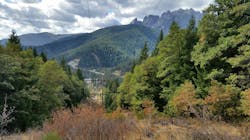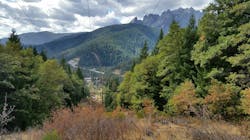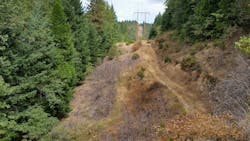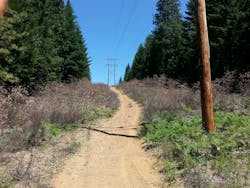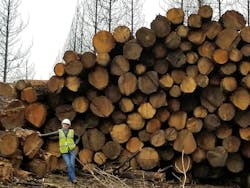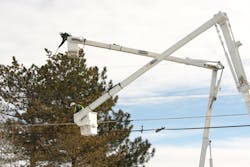Strategies to Mitigate Wildfire Risks and Protect Transmission
In 2020, wildfires burned more than 10 million acres of U.S. land, a considerable increase over the previous 20-year average of 7.1 million acres, according to the Congressional Research Service.
A range of factors are driving this increase. Most are ignited by lightning or humans, with discarded cigarettes, deserted campfires, acts of arson and car accidents representing the most common causes. However, electric facilities and equipment also have contributed to many significant wildfires.
According to the U.S. Department of Agriculture, fire seasons are also lasting longer due to climate-related environmental factors, including earlier snowmelt, delayed rainfall, extended drought, tree mortality and the spread of highly flammable invasive plant species.
While electric utility companies can’t control human behavior or the climate, they can mitigate the risk of wildfires before and after they occur by effectively managing their electric facilities and equipment. Pacific Power, a provider of safe and reliable electric service to customers throughout northern California, Oregon, and southeastern Washington, is prioritizing mitigation efforts using a wide array of methods to prevent wildfires and reduce the damage they cause.
A Serious Focus on Wildfire Mitigation
In Pacific Power’s service areas throughout California, Oregon and Washington, high temperatures and dry conditions make large regions of each state susceptible to wildfires. Ecological conditions also can vary from one region to the next. Different soil types, tree species and other environmental characteristics can create challenges for vegetation managers working to achieve consistent results, and site accessibility is often hindered by rough terrain or dense vegetation.
Utility foresters regularly work to inspect and assess the vegetation around Pacific Power-owned facilities. In addition to foot patrols, helicopter patrols and LiDAR are used to inspect transmission power lines and incorporate an additional assessment of trees from the air, especially in areas where the landscape is inaccessible by foot. This ongoing surveillance allows utility foresters to plan for the removal of vegetation that could pose a wildfire risk or jeopardize electrical transmission reliability.
Once incompatible vegetation has been identified, Pacific Power works to control targeted species promptly and effectively. Whereas mechanized mowing can provide short-term relief from these threats throughout right-of-way (ROW) corridors, Pacific Power enhances mowing results using an Integrated Vegetation Management (IVM) approach. This strategy helps to not only reduce the number of wildfires caused by utility facilities and equipment, but also prevent the spread of wildfires, providing environmental, social and economic benefits.
The Many Advantages of IVM
Mechanical control methods — like mowing — can temporarily eliminate vegetation hazards inside and outside of utility ROW corridors. But this strategy has its limits. Mowing can damage native plants, stimulate regrowth and support the spread of viable seeds. This can increase retreatment requirements and maintenance costs, creating more work and greater fire hazards over time.
Alternatively, an IVM strategy featuring selective herbicide applications is used to prevent the growth of incompatible vegetation without disturbing desirable plant species. Using this approach supports the development of low-growing grasses, forbs, and other native plants, and these low-growing plant communities provide multiple benefits:
- Prevent incompatible trees from reestablishing
- Stifle the spread of wildfire
- Support the development of pollinator habitat
Used as part of an IVM system, different herbicide tank mixes are required to effectively treat numerous incompatible species throughout hundreds of miles of ROW corridors. For example, Pacific Power contractors use an herbicide pre-mix in certain areas to provide at least 10 ft of radial clearance around electrical distribution and transmission poles. Certain suppliers, including Corteva Agriscience, provide straight product or contract mixes to meet vegetation managers’ unique needs. Corteva allows containers to be returned and refilled through its Continuum Prescription Control and Container Management System, which reduces waste and liability for improper container disposal.
“Many mixes control targeted vegetation to release grasses and forbs, which supports the development of pollinator habitat,” says Beau Miller, vegetation management specialist with Corteva Agriscience. “Around the poles, other herbicide mixes offer total vegetation control. Those mixes control weeds for eight to 10 months and keep the area clean for prevention measures.”
Selective herbicide mixes also are used to apply individual plant treatments on targeted trees and saplings. These individual treatments protect live conifers on the edges or outside of ROWs from residual control. In both scenarios, having the proper herbicide solutions on hand allows Pacific Power to remain flexible and consistent in its vegetation management approach without impacting environmental safety.
Proactive and Reactive Mitigation Work
Successful utility vegetation management programs are always addressing current issues while looking ahead to assess future threats. Pacific Power’s utility foresters identify candidate sites for future herbicide treatments. This determines which areas will be treated during each cycle and ensures that all right-of-way corridors meet clearance requirements established by their respective states. To streamline this work, Pacific Power uses a newly implemented database to identify incompatible vegetation in the field and track finished work in real time.
“Keeping a real-time tree inventory allows pest control advisors to provide written recommendations for various treatment methods and herbicide mixes that control vegetation issues on and around the line,” Miller says. “What Pacific Power is doing to identify incompatible vegetation and control it effectively should be considered an industry standard, particularly on the West Coast where wildfires are more prevalent.”
After a wildfire occurs, damaged trees are often left standing. Untreated, these trees could fall into power lines, making the prompt assessment of damage critical. Pacific Power works with external entities — such as the Bureau of Land Management, Forest Service and state highway transportation departments — to clear potential hazards that may threaten electrical transmission reliability or ROW accessibility. This work often requires the control of trees beyond the border zone, as some can reach up to 200 ft in height.
Once all existing hazards are removed, basal bark and cut-stump treatments can be used to prevent new problems. Basal bark treatments target trees that could potentially make contact with power lines in the future. These treatments allow herbicide formulations to penetrate a tree’s bark and reach the cambium layer. From there, herbicides translocate to roots and stems to eliminate the risk of regrowth or resprouting.
Cut-stump treatments are for trees that have already been removed. A selective herbicide mixture applied to the cambium, roots, and remaining exposed bark helps to prevent resprouting.
Collaboration and Communication
It’s not uncommon for various agencies to find themselves working side by side in the wake of a wildfire. Relationship-building and effective communication helps all parties work together and even synchronize their treatment cycles at times.
In California, Pacific Power has worked with a variety of public and private entities, including the California Department of Forestry and Fire Protection (CALFIRE), to improve conditions in northern California where wildfires have occurred. As state forest services like CALFIRE are often focused on fuel load reduction, their pruning and removal programs support the goals of utility companies that seek to enhance electrical transmission safety throughout ROW corridors.
In the Northwest, countless trees in and along ROWs exist beside land that is owned and managed by counties, states and the federal government. When wildfires occur near ROW corridors managed by Pacific Power, the utility often works with logging contractors or representatives from national parks, state forests, tribal nations, private entities and transportation departments.
Additionally, utilities must ensure protection for environmental, cultural and biological resources. They often hire professionals to survey and monitor archeological sites and ensure that there are no conflicts with sensitive or endangered species during post-wildfire mitigation work.
Outreach to Landowners and the Community
A considerable amount of ROW corridors managed by Pacific Power lie next to privately owned land. The interests and desires of private landowners can vary, with many Increasingly aware of the impact tall-growing vegetation can have on electrical transmission reliability and wildfire mitigation efforts. Effective communication with local landowners is absolutely critical for Pacific Power and other utility vegetation managers.
Landowners can feel understandably vulnerable after a wildfire, and chemical control methods, such as selective herbicide applications, may draw skepticism. Scrutiny often depends on a landowner’s experience with vegetation brownout and public misperceptions about herbicides.
Effective communication can help vegetation management professionals address landowner concerns, convey how the work of vegetation management teams can prevent future wildfires, and emphasize the importance of using industry best practices to ensure electrical transmission reliability and environmental safety.
After a wildfire, inspectors with Pacific Power work with vegetation crews to examine affected utility sites near private or public lands. Inspectors then contact local landowners to explain the vegetation management strategies that Pacific Power will use to advance their wildfire mitigation efforts in the future. All inspectors who work with Pacific Power are certified arborists. Their professional background and informative approach helps customers and community members understand the scope of work for utility vegetation management teams and contractors working in their area.
Tree Concerns
Few landowners want to lose their trees, but many understand why trees that have been burned need to be removed. Confusion can arise when trees that are burned only at their base or roots are nonetheless at risk of dying. Inspectors have the responsibility to explain to landowners why these trees are still at risk and how monitoring their development is necessary to ensure they do not die and eventually fall into power lines.
As part of its tree replacement program, Pacific Power may offer vouchers for landowners to replace trees through their local nursery. In some cases, contractors will remove trees and cut them into lengths that can be sold by landowners to local mills, providing some financial compensation for their losses.
Large chippers are sometimes used to break down remaining tree debris, which is then broadcasted primarily in sloped areas to address erosion issues. Pacific Power and logging contractors make a concerted effort to reinforce unstable land and restore vegetation lost at the hands of a wildfire. While these offerings do not make up for the devastating effects of wildfires, they help to improve the environment and lift the spirits of landowners after fires occur.
The Important Role of Utilities
Vegetation management strategies are a part of the many tools utility companies use to prevent wildfires. IVM strategies featuring selective herbicide applications enable electrical service providers to be fiscally and environmentally responsible in their efforts to mitigate wildfire risk and ensure electrical transmission reliability. As various factors continue to ignite wildfires across the country, utility companies that work to effectively prevent, prepare for, and respond to these events can help reduce their severity to provide environmental benefits and limit their impact on affected communities.
Lorelei Phillips has worked as a utility forester with Pacific Power for the past 14 years. In addition to being credentialed as a certified arborist and utility specialist arborist, she has earned her tree risk assessment qualification and holds an Oregon public applicator license. She uses nearly 26 years of industry experience to coordinate vegetation management work that helps to ensure safe and reliable electric service throughout northern California and southern Oregon.
About the Author
Lorelei Phillips
Lorelei Phillips has worked as a utility forester with Pacific Power for the past 14 years. In addition to being credentialed as a certified arborist and utility specialist arborist, she has earned her tree risk assessment qualification and holds an Oregon public applicator license. She uses nearly 26 years of industry experience to coordinate vegetation management work that helps to ensure safe and reliable electric service throughout northern California and southern Oregon.
